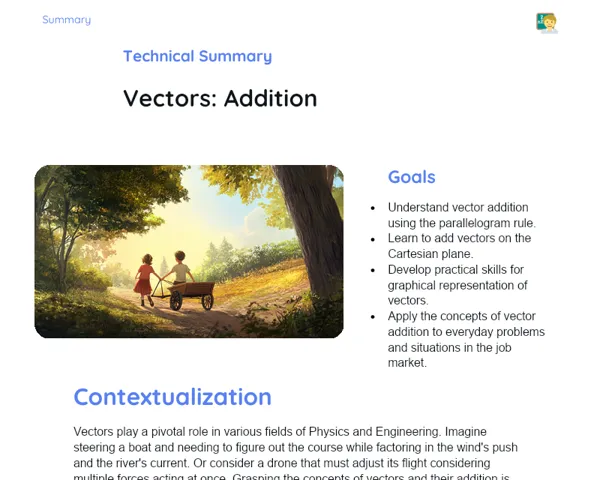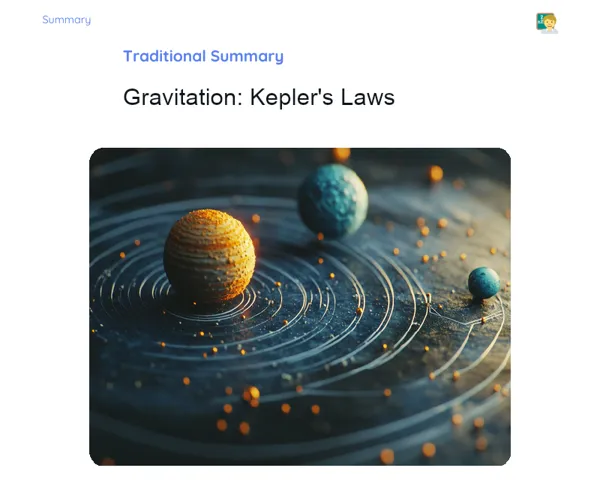Goals
1. Calculate the mechanical energy of basic physical systems.
2. Identify scenarios where mechanical energy is conserved or dissipated.
3. Solve real-life problems involving the conservation of mechanical energy, such as a block sliding down a slope.
Contextualization
Mechanical energy is a fundamental type of energy we encounter in our everyday lives. From cycling and playing cricket to operating heavy machinery in industries, mechanical energy is everywhere. Grasping the mechanics of this energy, including its conservation and transformation, is vital for a range of applications in engineering, physics, and cutting-edge fields like robotics and electric vehicles. For example, when a roller coaster makes its descent, gravitational potential energy is transformed into kinetic energy, showcasing the principle of conservation of mechanical energy.
Subject Relevance
To Remember!
Kinetic Energy
Kinetic energy refers to the energy an object holds due to its movement. It is influenced by the mass of the object and its speed. The formula for calculating kinetic energy is E_k = 1/2 mv^2, where m represents the mass and v denotes the speed.
-
Kinetic energy increases with the square of the speed.
-
Heavier objects possess more kinetic energy than lighter ones if both are moving at the same speed.
-
Kinetic energy is always a positive value, as it relies on the square of the speed.
Gravitational Potential Energy
Gravitational potential energy is the energy an object possesses due to its position within a gravitational field. For objects positioned close to the Earth's surface, the formula is E_p = mgh, where m stands for mass, g is the acceleration due to gravity, and h indicates height.
-
The higher the object is raised, the greater its gravitational potential energy.
-
Gravitational potential energy can convert into kinetic energy when an object descends.
-
Potential energy is contingent on the mass of the object and its height compared to a reference point.
Conservation of Mechanical Energy
The conservation of mechanical energy principle indicates that the total mechanical energy of a system (the combination of kinetic and potential energy) remains constant when only conservative forces (like gravity) are in play. In real-world scenarios, energy may be lost due to friction or other non-conservative forces.
-
Total mechanical energy is the sum of kinetic and potential energy.
-
In an ideal frictionless scenario, mechanical energy is preserved.
-
Conservation of mechanical energy is a core principle in various branches of physics and engineering.
Practical Applications
-
Roller Coasters: Roller coasters are designed based on principles of kinetic and potential energy. The starting height determines the potential energy, which transforms into kinetic energy as the carriage moves downhill.
-
Wind Turbines: Wind turbines convert the kinetic energy of wind into mechanical energy, which is subsequently transformed into electrical energy.
-
Vehicles: In automobiles, the chemical energy derived from fuel is transformed into mechanical energy to propel the vehicle, which demonstrates energy transformation and conservation.
Key Terms
-
Mechanical Energy: The total of kinetic and potential energy in a system.
-
Kinetic Energy: The energy related to the motion of objects, computed as E_k = 1/2 mv^2.
-
Gravitational Potential Energy: Energy related to an object's position in a gravitational field, calculated as E_p = mgh.
-
Conservation of Mechanical Energy: The principle asserting that the total mechanical energy of an isolated system remains constant if only conservative forces are acting.
Questions for Reflections
-
How can mechanical energy contribute to enhancing energy efficiency across various industries?
-
What are the implications of conserving mechanical energy for advancing new technologies, such as self-driving cars or robotic systems?
-
In what ways can a solid understanding of kinetic and potential energy concepts shape a mechanical engineer's career?
Analyzing Energy Conservation on a Ramp
In this mini-challenge, you will create a simple ramp and evaluate the transformation and conservation of mechanical energy as an object slides down. This hands-on exercise will reinforce your understanding of kinetic and potential energy concepts, along with the principle of conservation of mechanical energy.
Instructions
-
Form groups of 4-5 students.
-
Use the provided materials (cardboard, ruler, tape, wooden block or toy car, stopwatch) to set up an inclined ramp.
-
Measure the initial height of the ramp and the length of the track.
-
Release the block from the top of the ramp and time its descent.
-
Compute the initial potential energy (E_p = mgh) and final kinetic energy (E_k = 1/2 mv^2) using the block's mass and the calculated speed (v = length of the track / time).
-
Discuss within your group whether mechanical energy was conserved, accounting for energy losses due to friction.
-
Document your observations and conclusions regarding the conservation of mechanical energy.



